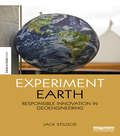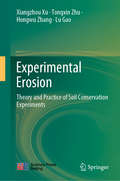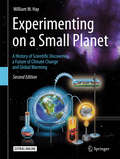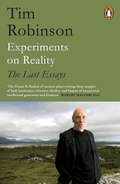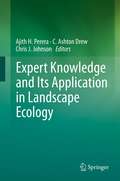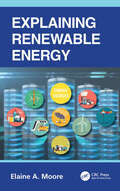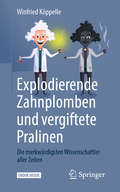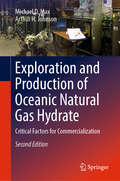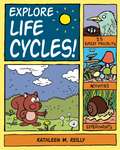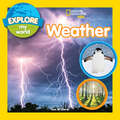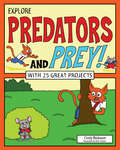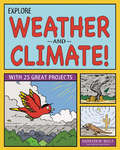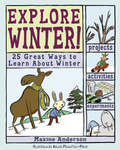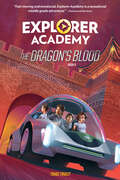- Table View
- List View
Experiment Earth: Responsible innovation in geoengineering (The Earthscan Science in Society Series)
by Jack StilgoeExperiments in geoengineering – intentionally manipulating the Earth’s climate to reduce global warming – have become the focus of a vital debate about responsible science and innovation. Drawing on three years of sociological research working with scientists on one of the world’s first major geoengineering projects, this book examines the politics of experimentation. Geoengineering provides a test case for rethinking the responsibilities of scientists and asking how science can take better care of the futures that it helps bring about. This book gives students, researchers and the general reader interested in the place of science in contemporary society a compelling framework for future thinking and discussion.
Experimental Approaches to Conservation Biology
by Malcolm S. Gordon Soraya M. BartolEnvironmental and biological researchers from around the world present a selection of current case studies relevant to protecting world biodiversity that illustrate issues in both basic and applied experimental biology, at a level accessible to students and non scientists as well as active researcher. The also want to raise the visibility of organism-centered experimentation as a valid and useful approach to conservation biology, and to narrow the gap that divides researchers from managers and policymakers charged with protecting biodiversity. The 18 selected papers were to be presented a September 2001 conference in Los Angeles, but some were not delivered because air traffic was closed and authors could not reach Los Angeles. Annotation ©2004 Book News, Inc., Portland, OR (booknews.com)
Experimental Erosion: Theory and Practice of Soil Conservation Experiments
by Xiangzhou Xu Tongxin Zhu Hongwu Zhang Lu GaoThis book is the first to systematically explore experimental erosion by integrating theory, erosion observations, and conservation applications. Although numerous books have been published on soil erosion both in English and in Chinese, none has concentrated on experimental studies on the Loess Plateau of China, in an attempt to establish a new sub-discipline: experimental erosion. One main objective of this book is to highlight monitoring and modeling methods for soil scientists who design and conduct experimental studies on soil loss. Another objective, and the most important one, is to make the results of these experiments more generally available. Accordingly, we have gathered and integrated a broad range of experimental results, both published and unpublished. In-depth discussions of the experimental data and new data processing methods are also included. The work covered here represents exemplary studies in the field of soil erosion and conservation, while the new methods and findings presented will provide practical guidance for controlling soil erosion. Hence the book offers a valuable resource for graduate students, soil erosion scientists and engineers, and soil and water conservationists.
Experimenting on a Small Planet
by William W. HayThis book is a thorough introduction to climate science and global change. The author is a geologist who has spent much of his life investigating the climate of Earth from a time when it was warm and dinosaurs roamed the land, to today's changing climate. Bill Hay takes you on a journey to understand how the climate system works. He explores how humans are unintentionally conducting a grand uncontrolled experiment which is leading to unanticipated changes. We follow the twisting path of seemingly unrelated discoveries in physics, chemistry, biology, geology, and even mathematics to learn how they led to our present knowledge of how our planet works. He explains why the weather is becoming increasingly chaotic as our planet warms at a rate far faster than at any time in its geologic past. He speculates on possible future outcomes, and suggests that nature itself may make some unexpected course corrections. Although the book is written for the layman with little knowledge of science or mathematics, it includes information from many diverse fields to provide even those actively working in the field of climatology with a broader view of this developing drama. Experimenting on a Small Planet is a must read for anyone having more than a casual interest in global warming and climate change - one of the most important and challenging issues of our time.
Experiments on Reality
by Tim RobinsonLong recognized as perhaps the greatest non-fiction writer at work in Ireland, for his vast, polymathic accounts of nature and culture in the Aran Islands and Connemara, Tim Robinson is also an essayist of genius whose fascinations range across the globe. In Experiments on Reality, he shines the light of his intelligence on his own life, and on some of the most fascinating questions in science and culture. Robinson brings us to his boyhood in Yorkshire, National Service in Malaya in the 1950s, and his years as a visual artist in Istanbul, Vienna and London. He revisits some of the scenes of his researches for the maps he made of Aran and Connemara, places that continue to throw up remarkable stories and puzzles. And he performs astonishing literary thought-experiments, playing with the boundaries of the essay form, scientific inquiry, and storytelling. Experiments on Reality is a masterpiece from one of the great minds of our time.'One of the greatest of all landscape writers ... When the material world is brought forth for us so beautifully, with such rapt attention and illuminating insight, we are reminded of how lucky we are to be part of it' Fintan O'Toole, Irish TimesPRAISE FOR THE CONNEMARA TRILOGY:'One of the most remarkable non-fiction projects undertaken in English' Robert MacFarlane, Spectator'Robinson is a marvel ... the supreme practitioner of geo-graphy, the writing of places' Fintan O'Toole, Observer Books of the Year'One of contemporary Ireland's finest literary stylists ... This is a book that does justice, in every sense of that phrase, to the frequently betrayed people whose stories it incarnates, and to their strange and beautiful corner of the world' Joseph O'Connor, Guardian'A masterpiece of travel and topographical writing and a miraculous, vivid and engrossing meditation on landscape and history and the sacred mood of places' Colm Tóibín, Irish Times Books of the Year'One of the finest of contemporary prose stylists' John Burnside, Irish Times'He is that rarest of phenomena, a scientist and an artist, and his method is to combine scientific rigour with artistic reverie in a seamless blend that both informs and delights.' John Banville, Guardian'Breathtaking ... the West of Ireland has found its ultimate laureate' Patricia Craig, TLS'Dazzling ... an indubitable classic' Giles Foden, Condé Nast Traveller
Experiments with Plants: A True Book
by Salvatore TocciNine easy-to-follow experiments help readers explore what a plant is, what it needs to grow and live, what's inside a plant seed, and how seeds grow and get spread in the wild.
Expert Knowledge and Its Application in Landscape Ecology
by C. Ashton Drew Chris J. Johnson Ajith H. PereraTypically, landscape ecologists use empirical observations to conduct research and devise solutions for applied problems in conservation and management. In some instances, they rely on advice and input of experienced professionals in both developing and applying knowledge. Given the wealth of expert knowledge and the risks of its informal and implicit applications in landscape ecology, it is necessary to formally recognize and characterize expert knowledge and bring rigor to methods for its applications. In this context, the broad goal of this book is to introduce the concept of expert knowledge and examine its role in landscape ecological applications. We plan to do so in three steps: First we introduce the topic to landscape ecologists, explore salient characteristics of experts and expert knowledge, and describe methods used in capturing and formalizing that knowledge. Second, we present examples of research in landscape ecology from a variety of ecosystems and geographic locations that formally incorporate expert knowledge. These case studies address a range of topics that will interest landscape ecologists and other resource management and conservation professionals including the specific roles of expert knowledge in developing, testing, parameterizing, and applying models; estimating the uncertainty in expert knowledge; developing methods of formalizing and incorporating expert knowledge; and using expert knowledge as competing models and a source of alternate hypotheses. Third, we synthesize the state of knowledge on this topic and critically examine the advantages and disadvantages of incorporating expert knowledge in landscape ecological applications. The disciplinary subject areas we address are broad and cover much of the scope of contemporary landscape ecology, including broad-scale forest management and conservation, quantifying forest disturbances and succession, conservation of habitats for a range of avian and mammal species, vulnerability and conservation of marine ecosystems, and the spread and impacts of invasive plants. This text incorporates the collective experience and knowledge of over 35 researchers in landscape ecology representing a diverse range of disciplinary subject areas and geographic locations. Through this text, we will catalyze further thought and investigations on expert knowledge among the target readership of researchers, practitioners, and graduate students in landscape ecology.
Explaining Renewable Energy
by Elaine A. MooreThis undergraduate text aimed primarily at high schoolers and lower level undergraduates focuses on explaining how the various forms of renewable energy work and the current ongoing research. It includes sections on non-scientific aspects that should be considered such as availability of resources. A final chapter covers methods of removing carbon dioxide from the atmosphere.Renewable energy is currently on everyone’s mind in the context of climate change. This text provides students with an introduction into the science behind the various types of renewable energy enabling them to access review literature in the field and options that that should be considered when selecting methods. Features Collates the most relevant and up to date information on renewable energy systems in a user friendly format for undergraduate and high school students. Focuses on power production technologies from renewable energy sources. An introduction to how sources of renewable energy work; their advantages and drawbacks. Timely text with the need for fast adoption of renewable energy technologies around the world. Suitable for a diverse audience including students with some scientific background such as final year in high school wanting to know more about combatting climate change.
Explaining Risk Analysis: Protecting health and the environment (Earthscan Risk in Society)
by Michael R GreenbergRisk analysis is not a narrowly defined set of applications. Rather, it is widely used to assess and manage a plethora of hazards that threaten dire implications. However, too few people actually understand what risk analysis can help us accomplish and, even among experts, knowledge is often limited to one or two applications. Explaining Risk Analysis frames risk analysis as a holistic planning process aimed at making better risk-informed decisions and emphasizing the connections between the parts. This framework requires an understanding of basic terms, including explanations of why there is no universal agreement about what risk means, much less risk assessment, risk management and risk analysis. Drawing on a wide range of case studies, the book illustrates the ways in which risk analysis can help lead to better decisions in a variety of scenarios, including the destruction of chemical weapons, management of nuclear waste and the response to passenger rail threats. The book demonstrates how the risk analysis process and the data, models and processes used in risk analysis will clarify, rather than obfuscate, decision-makers’ options. This book will be of great interest to students and scholars of risk assessment, risk management, public health, environmental science, environmental economics and environmental psychology.
Explanatorium of the Earth (DK Explanatorium)
by DKWelcome to the Explanatorium of the Earth - the only Earth encyclopedia for children you'll ever need, with amazing photographs of everything from supervolcanoes to tsunamis.What makes volcanoes erupt? Why are tornadoes and hurricanes so destructive? How do rocks, fossils, and gems form? Explanatorium of the Earth takes you on an incredible voyage deep into the heart of our planet and back to discover the powerful forces that continually shape and remodel our ever-changing world. Discover how tectonic plates tear apart and collide, moving inch by inch to create continents, mountain ranges, oceans, and volcanoes. Witness the destructive power of earthquakes, tsunamis, and hurricanes. Learn how the slow but relentless process of erosion and weathering wear away rock, reducing mountains to dust and carving valleys and canyons into the land. And learn how the living world and rock cycles have worked together for millions of years to stabilize the planet's climate, keeping Earth suitable for life.
Explodierende Zahnplomben und vergiftete Pralinen: Die merkwürdigsten Wissenschaftler aller Zeiten
by Winfried KöppelleEin schottischer Genetiker begeistert sich für Sauerstoffentzug und Stickstoffvergiftungen, pustet sich Zigarrenrauch durchs perforierte Trommelfell und steckt die eigene Gattin in seine Unterdruckkammer.Eine inselbegabte Autistin kriecht auf allen Vieren durch Schlachthöfe, entspannt sich in ihrer selbsterfundenen „Presskiste“, und steigt zur führenden Expertin für humanes Metzgerhandwerk auf.Ein Selfmade-Chemiker rottet mit seinen Erfindungen beinahe die Menschheit aus – und erwürgt sich mit einer seiner Konstruktionen versehentlich selbst.Ein Anthropologie-Professor fabriziert an der Uni illegale Drogen und wandert hinter Gitter. Nach seiner Entlassung schickt er seinem Richter vergiftete Pralinen – und bekommt lebenslänglich.Wer schon immer vermutete, dass intelligente Menschen oft auch sehr eigenartige Zeitgenossen sind – hier der Beweis: Zehn Kurzbiografien zwischen Genie und Wahnsinn – zehnmal Unerhörtes, Sagenhaftes, Haarsträubendes und Skandalöses aus der elitären Welt der Spitzenforschung.
Exploration and Production of Oceanic Natural Gas Hydrate: Critical Factors For Commercialization
by Michael D. Max Arthur H. JohnsonThis second edition provides extensive information on the attributes of the Natural Gas Hydrate (NGH) system, highlighting opportunities for the innovative use and modification of existing technologies, as well as new approaches and technologies that have the potential to dramatically lower the cost of NGH exploration and production.Above all, the book compares the physical, environmental, and commercial aspects of the NGH system with those of other gas resources. It subsequently argues and demonstrates that natural gas can provide the least expensive energy during the transition to, and possibly within, a renewable energy future, and that NGH poses the lowest environmental risk of all gas resources.Intended as a non-mathematical, descriptive text that should be understandable to non-specialists as well as to engineers concerned with the physical characteristics of NGH reservoirs and their production, the book is written for readers at the university graduate level. It offers a valuable reference guide for environmentalists and the energy community, and includes discussions that will be of great interest to energy industry professionals, legislators, administrators, regulators, and all those concerned with energy options and their respective advantages and disadvantages.
Explore Life Cycles!
by Kathleen M. Reilly Bryan StoneExplore Life Cycles! takes kids on an amazing journey, where they'll learn about the changes plants and animals experience throughout their lives. Kids ages 6-9 will discover what happens inside those magical cocoons to transform a caterpillar into a butterfly. They'll explore how frogs breathe underwater as tadpoles, then use lungs as an adult. Explore Life Cycles! will examine how plants and animals are born, develop, and live their lives.Activities range from creating edible life cycles of insects to making a mealworm nursery. Using an eye-catching combination of cartoons, fun facts, and exciting projects, Explore Life Cycles! will bring the mysteries of life right into kids' hands.
Explore My World: A Tree Grows Up (Explore My World)
by Marfe Ferguson DelanoIn this charming picture book, curious little kids will learn all about how an acorn grows up to be an oak tree. The story includes the stages of growth of a tree throughout the seasons and year. It also introduces the happenings around the tree, from children playing in its shade to squirrels climbing up its trunk and birds nesting in its branches. These engaging Explore My World picture books on subjects kids care about combine simple stories with unforgettable photography. They invite little kids to take their first big steps toward understanding the world around them and are just the thing for parents and kids to curl up with and read aloud.
Explore My World: Weather (Explore My World)
by Lisa M. GerryPacked with colorful photographs of adorable animals braving the elements, this picture book for preschoolers introduces kids to the weather they experience every day, including rain, clouds, sunshine, snow, storms, and more.From snowflakes to raindrops to puddles, from sunny days to cloudy days to blustery days, young readers will be amazed by the wondrous and ever-changing world of weather. These engaging Explore My World picture books, on subjects kids care about, combine simple storytelling with unforgettable photography. They invite little kids to take their first big steps toward understanding the world around them and are just the thing for parents and kids to curl up with and read aloud.
Explore Predators and Prey!: With 25 Great Projects
by Cindy Blobaum Matt AucoinHunting, hiding, trapping, and tricking are just a few of the strategies used by animals in the wild to ensure they eat enough without being eaten themselves! In Explore Predators and Prey! With 25 Great Projects, readers ages 7 through 10 explore the physical and behavioral adaptations of predators and prey and their impact on the environment.Predators, such as hawks and foxes, have keen eyesight and sharp beaks and teeth to help them catch their prey. Prey, such as mice and rabbits, have large ears to hear danger and can move quickly to escape their enemies. Animal populations are closely integrated with each other and the surrounding environment. A change to one population causes changes to all others. Readers discover how repercussions can affect nature, including humans, and are encouraged to consider their own actions with an eye toward the effect on the environment.In Explore Predators and Prey, kids actively learn about body tools and behavior strategies as they test their own abilities to hunt and hide in a series of science-minded activities. Fun facts and colorful cartoons make learning entertaining and links to online primary sources and videos make the content accessible to all learners.
Explore Spring!
by Lauri Berkenkamp Alexis Frederick-FrostFrom tracking spring peepers and raising tadpoles to learning about seeds and recording plant growth, Explore Spring! 25 Great Ways to Learn About Spring invites young readers to explore the wonders of spring by becoming scientists in the field. Combining hands-on learning with solid science, trivia, riddles, and terrific illustrations, projects investigate "the reason for the season" and include identifying trees and measuring their growth, recording soil temperature, and observing the forest floor. Bird migration and nest building are covered, and the movement of air and water is studied with experiments in capillary action and in such activities as "Making Parachutes," Making Kites," and "Mapping Air Currents with Bubbles."
Explore Weather and Climate!
by Bryan Stone Kathleen M ReilleyWhat's it like outside? And what are you going to do about it?Every morning, before heading to school or out to play, kids want to know what the weather is going to be like that day. Is it a day for building a snowman, constructing a sandcastle, or planting a garden? Will they be stuck inside because of rain at recess? Or stuck at home because of snow? And what about tomorrow? Explore Weather and Climate! will help kids understand the "how" and "why" behind the "what." They'll learn how wind, sun, and water combine to form the weather we experience every day. They'll find out why the weather gets extreme. Explore Weather and Climate! offers engaging text reinforced with 25 hands on projects that include creating a storm in a bottle, touching the clouds, and eating an edible climate map, resulting in an unforgettable understanding of these forces of nature.
Explore Winter!
by Maxine Anderson Alexis Frederick-FrostYoung readers become scientists in the field when this activity book sends them off to answer the question "Why do we have winter?" with experiments and projects that mix real science with real fun. Combining hands-on learning with trivia, jokes, riddles, and terrific illustrations, chapters start with the "tools" of science-the scientific method and how to keep a science journal-and then investigate the winter constellations, long nights and long shadows, animal tracking in snow, and food-gathering behavior in birds.
Explore Winter!: 25 Great Ways to Learn About Winter
by Maxine Anderson Alexis Frederick-FrostYoung readers become scientists in the field when Explore Winter! sends them off to answer the question "Why do we have winter?" with experiments and projects that mix real science with real fun. Combining hands-on learning with trivia, jokes, riddles, and terrific illustrations, chapters start with the "tools" of science-the scientific method and how to keep a science journal-and then investigate the winter constellations, long nights and long shadows, animal tracking in snow, and food-gathering behavior in birds.
Explore the Salish Sea: A Nature Guide for Kids
by Joseph K. Gaydos Audrey DeLella BenedictFilled with beautiful photography and engaging text, Explore the Salish Sea inspires children to explore the unique marine ecosystem that encompasses the coastal waters from Seattle's Puget Sound up to the Strait of Juan de Fuca and the Georgia Strait of British Columbia.Discover the Salish Sea and learn about its vibrant ecosystem in this engaging non-fiction narrative that inspires outdoor exploration. Filled with full-color photography, this book covers wildlife habitats, geodiversity, intertidal and subtidal sea life, and highlights what is unique to this Pacific Northwest ecosystem.
Explore! Theodore Roosevelt National Park: A Guide To Exploring The Roads, Trails, River, And Canyons (Exploring Series)
by Levi NoveyThis comprehensive guide provides general logistical information for park visitors plus interpretive information about Theodore Roosevelt National Park and its features, from its famous painted canyons to its petrified forests. Information on driving tours, suggested hikes, stories and legends about the life of Theodore Roosevelt, and nearby cultural and recreational opportunities round out this guidebook.
Explorer Academy: The Dragon's Blood (Explorer Academy)
by Trudi TrueitAn explosive revelation and a familiar face in the sixth book in this adventure-packed series. Still reeling from the life-changing discovery he found buried in the mysterious archive, Cruz Coronado grapples with an important secret as the gang heads to China in search of the second-to-last piece of the cipher. Under the watchful eye of a new adviser, life on the ship returns to almost normal...Almost. Just as things seem to be going smoothly, a familiar face shocks Cruz back into reality, and the final piece in this life-and-death scavenger hunt veers toward a dead end. Explorer Academy features: Gripping fact-based fiction plot that inspires curiosity with new technology and innovations; Amazing inventions and gadgets; A cast of diverse, relatable characters; Secret clues, codes, and ciphers to track down within the text; Vibrant illustrations, Elements of STEAM; National Geographic explorer profiles in The Truth Behind Section. Complete your collection with: The Nebula Secret (1) The Falcon's Feather (2) The Double Helix (3) The Star Dunes (4) The Tiger's Nest (5) Explorer Academy Code-Breaking Adventure Explorer Academy Ultimate Activity Challenge Explorer Academy Field Journal Explorer Academy Future Tech
Explorer Academy: The Forbidden Island (Explorer Academy)
by Trudi TrueitA heart-pounding final showdown changes the life of Cruz Coronado forever in the seventh and final book in this thrilling fact-based fiction series. Amid assignments that take the Explorer Academy recruits from the iceberg-filled waters of Antarctica to the bone-dry deserts of Argentina, Cruz Coronado is scrambling to complete the last piece of the cipher. With Nebula agents and the elusive explorer spy still out there, his opportunity to recover his mother's world-changing formula is slipping away. But as Cruz has learned from his time aboard Orion, true explorers must never give up. Even after completing dozens of high-risk missions and traveling to all seven continents, Cruz could never prepare himself for one ultimate surprise. Explorer Academy features: Gripping fact-based fiction plot that inspires curiosity with new technology and innovations; amazing inventions and gadgets; a cast of diverse, relatable characters; secret clues, codes, and ciphers to track down within the text; vibrant illustrations; elements of STEAM; National Geographic explorer profiles in the "Truth Behind" section. Complete your collection with: The Nebula Secret (1) The Falcon's Feather (2) The Double Helix (3) The Star Dunes (4) The Tiger's Nest (5) The Dragon's Blood (6) Explorer Academy Codebreaking Activity Adventure Explorer Academy Ultimate Activity Challenge Explorer Academy Field Journal Explorer Academy Future Tech
Explorer's Guide 50 Hikes Around Anchorage (Explorer's 50 Hikes)
by Lisa MaloneyThe best hikes in--and beyond--the web of trails that covers the Anchorage area, from well-known treks to little-know gems. 50 Hikes Around Anchorage is your guide to exploring everything in this hub of cultural and outdoor life, from never-before-published wilderness routes to miles of mountain footpaths and National Recreation Trails. All hikes are within a 30-minute drive of the city and include such sites as the Iditarod Trail, Campbell Tract, Rendezvous Peak, Mount Baldy, and so much more. Routes pass over foothills and alongside streams, showcasing the region's natural beauty and pristine wilderness areas. You'll find cultural and natural history on each of the routes, detailed directions to the trailheads, GPS coordinates, topographic maps, information on local rules and regulations, and details on Leave No Trace ethics.
